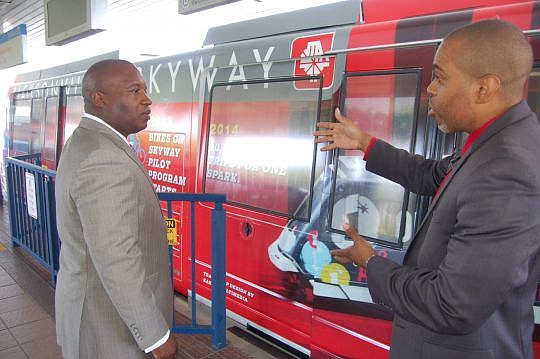
Jacksonville’s automated, elevated monorail system marked its 25th anniversary Tuesday with JTA officials offering a look back – and a look ahead.
Nathaniel Ford, CEO of JTA, said the authority has commissioned a study of the Skyway’s future, both in terms of maintaining the service in its present state and looking toward the future, including extending the routes and possibly upgrading the 25-year-old technology.
“We want to keep the existing system in good repair and we want to examine the cost to expand the technology throughout the urban core,” he said.
The schedule to extend the Skyway to the Brooklyn neighborhood near the 220 Riverside apartment development and Unity Plaza should be finalized by the end of summer, Ford said.
Other options could one day include adding service to EverBank Field, Metropolitan Park and to UF Health in Springfield.
Tuesday was a “monumental day,” Ford said, and a celebration of what the Skyway means to the community.
Part of the milestone observance was the unveiling of newly wrapped Skyway cars that commemorate the silver anniversary.
Wrapping Skyway cars was first used in March and April to promote the One Spark festival. Ford said decorating the Skyway lets people “identify it with their lifestyle” and makes the vehicles more attractive. The Jacksonville Jaguars or EverBank could use the Skyway to promote their brands.
“Jacksonville’s icons can be part of the landscape,” Ford said.
In 1971, the city approved a federal planning grant to fund a study of the feasibility of an urban “people mover.”
Jacksonville received $23 million in federal funds in 1985 to build an Automated Skyway Express. Construction began in 1987 and two years later, a .7-mile starter line opened between Central Station and the Prime Osborn Convention Center.
When the Skyway began operating in 1989, it was one of only five systems in America. The others are in Detroit; Irving, Texas; Miami; and Morgantown, W.Va.
In 1992, development began on the second phase and in 1998, the system was completed with 2.5 miles of track and eight stations from the JTA mass transit hub along State and Union streets to stops across the St. Johns River to San Marco and the Kings Avenue Parking Garage.
“The Skyway has received a number of negative comments, but it has proved its worth,” said JTA board Chair Donna Harper.
She cited the more than 100,000 passengers who used the Skyway during Super Bowl XXXIX in 2005 and the more than 90,000 passengers that used it during One Spark.
JTA estimates that more than 13 million trips have been taken on the Skyway since it opened in 1989, with 2013 being the first time it passed 1 million rides in one year.
City Council President Bill Gulliford said future Downtown development is “intertwined” with the Skyway.
“If we develop Downtown properly, the Skyway can be an important element to connect parking with employment and housing,” he said. “If this all evolved in a way that cars were prohibited in the urban core, how important would the Skyway be?”
@DRMaxDowntown
(904) 356-2466